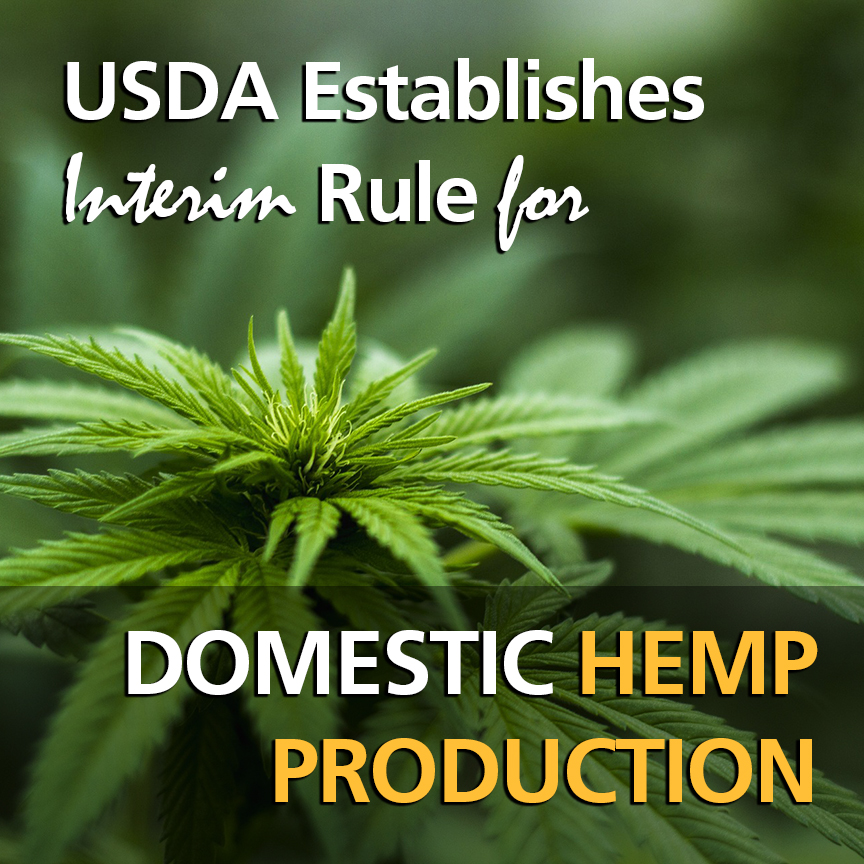USDA Establishes Interim Rule for Domestic Hemp Production

The USDA has, at long last, published interim final rules for the federal regulation of hemp. The program establishes the standards for maintaining information on the land where hemp is grown, testing for THC, disposal of non-compliant plants, licensing, and compliance. The interim rule is effective on October 31, 2019 and runs through November 1, 2021. Comments are invited and may be submitted through the federal www.regulations.gov portal until December 30, 2019.
Every State or Tribe may submit a plan, to be approved or rejected within 60 days. In the event a State or Tribe does not submit a plan, the USDA plan provides the backstop.
There is a lot to unpack in the new rule. In a broad sense, 16 items jump out, and any one of these items is worthy of much deeper follow up.
- All plans submitted to the USDA for approval must provide methodology to collect and maintain relevant information on the land used for hemp farming, including geospatial locations.
- Producers must report their hemp acreage to the USDA Farm Service Agency.
- Seeds must be complaint, but the USDA will not certify a seed program because the same seeds might produce a variety of result depending on where they are planted.
- All plans must incorporate procedures for sampling and testing hemp to ensure that cannabis does not exceed the acceptable THC level.
- Testing must be completed by a DEA –registered laboratory using reliable testing procedures.
- All plans with a THC concentration more than 0.3% THC concentration on a dry weight basis must be destroyed in accordance with an approved plan, or USDA guidelines.
- Laboratories must include a measurement of uncertainty (MU) when they report results, and labs should meet the AOAC International standard in selecting methodology.
- Laboratories conducting hemp testing must be registered with the DEA in keeping with 21 CFR 13001.13.
- All plans must provide for the effective disposal of non-compliant plants.
- All plans must provide compliance guidelines to ensure that hemp production is actually compliant, and include procedures for handling violations. All plans must have processes to handle violations for failing to provide legal descriptions, failure to obtain a license, and the production of non-compliant plants. More stringent guidelines are permitted.
- All plans will provide for corrective action in the case of negligent violations, as defined.
- All plans must provide remedial provision for violations made with an intent exceeding negligence, meaning made intentionally, knowingly, or recklessly. If so determined, all plans will provide for reporting to the Attorney General, the USDA, and chief law enforcement of the issuing authority.
- Anyone with a felony in the past 10 years is prohibited from participating, with certain exceptions.
- All plans must provide for the review of criminal history reports for key participants in hemp production.
- Certain items must be reported to the USDA. This includes all information related to individuals deemed key participants, all members of any participating business entity, legal descriptions and geospatial information where hemp is grown, and licensee status under any authorized hemp production program.
- All plans must certify that they have the personnel to carry out the programs requirements.
Also, now compliant hemp seeds can be imported from Canada and any other country if accompanied by a phytosanitary certificate from the exporting country’s national plant production organization to verify the origin and confirm the lack of pests. Because seed importation is governed by the USDA’s Animal and Plant Inspection Service (APHIS) regulations, nothing more detailed is provided in the new regulations. Also, the interstate transport of hemp is provided for, but not hemp exports. The interstate transport regulations also refer specifically to hemp’s “derivatives, extracts, cannabinoids, isomers, acids, slats of isomers, whether growing or not,” with a THC concentration below .3% on a dry weight basis. This is a very welcome and expansive reading of the 2018 Farm Bill’s text.
Kentucky has submitted a plan to the USDA, and with the regulations in place, should have approval from the USDA no later than 12/31/2019, and in time for the 2020 planting season. Ohio has not yet taken the steps necessary to take advantage of the new hemp regulations.
Please contact Steve Smith with any questions.
Related Attorneys
- office 859.578.3070
Media Contact
- office 513.629.2896

